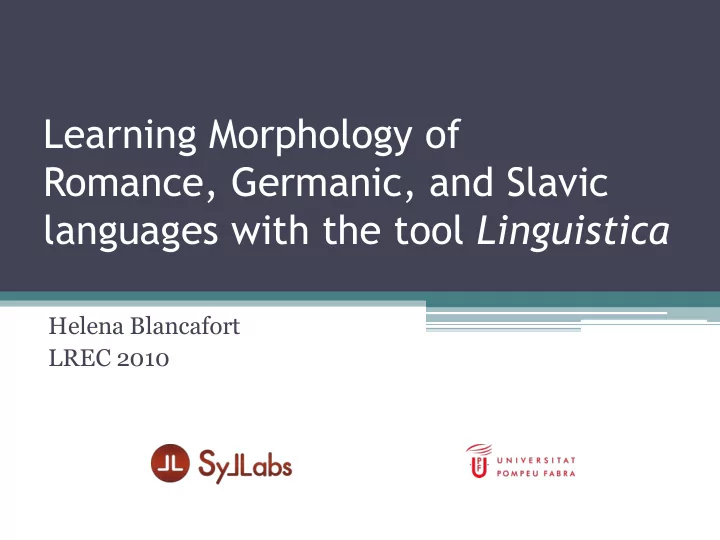

Learning Morphology of Romance, Germanic, and Slavic languages with the tool Linguistica Helena Blancafort LREC 2010
2 LREC 2010 20/05/2010 Outline 1. Introduction 2. State of the art 3. Linguistica: How it works 4. Experiments and Results 5. Conclusions and further work
3 LREC 2010 20/05/2010 Introduction Motivation How can we predict the cost of developing a morphosyntactic lexicon for a new language? Goals Evaluate if we can benefit from unsupervised learning of morphology Input: Bible parallel corpus, tool Linguistica (Goldsmith 2001, 2006)
4 LREC 2010 20/05/2010 State of the Art: Induction of morphology Objective - induce morphological information from raw data Affix • Brent et al. 1995; Kazakov, 1997 inventory • MDL (Rissanen ,1998) Cluster of • Schone and Jurafsky 2001; stems and • Yarowsky andWicentowski 2001 affixes
5 LREC 2010 20/05/2010 State of the Art II Using linguistic knowledge or not • Nakov et al (2003); Oliver (2005) • Learn all possible endings of an unknown word Lexicon • Apply Maximum Likelihood Estimation (Mikheev) • Clément et al. (2004) Inflection • Fosbert et al (2006); Loupy et al. (2008) Rules • Pos-tagger Zanchetta and Baroni (2005)
6 LREC 2010 20/05/2010 Linguistica: How it works I • Knowledge-free • Input: raw corpus • Heuristics to generate a probabilistic morphological grammar • MDL (minimum length description) & EM (expectation-maximization algorithm) to filter out inappropriate analysis
7 LREC 2010 20/05/2010 Linguistica: How it works II Signatures Paradigm-like clusters with words sharing the same affixes could help to build a morphological grammar The algorithm: - Splits a word into stem and affix - For each stem, list of affixes - Cluster of stems sharing the same affixes
8 LREC 2010 20/05/2010 Linguistica: How it works III Signatures NULL.ed.ing.s 68 7889 gather abound account ascend ask belong boil chasten concern confirm consider delay doubt encamp enter exceed explain fail fasten fold gain gather glean greet groan guard hang happen harden insult journey knock lack leap lift listen look minister number obey offer overflow
9 LREC 2010 20/05/2010 Linguistica: How it works IV Main hurdles 1) Allomorphy ES colgar -> colg, cuelg FR acheter -> achet, achèt 2) Incomplete paradigms due to bad segmentation Spanish verb anunciar: anunci(o, en, etc.) , anunciab(a) 3) No distinction between inflectional and derivational suffixes
10 LREC 2010 20/05/2010 Experiments and Results I number of suffixes generated by Linguistica 600 500 400 300 200 100 0 pl it cat es fr pt de nl en
11 LREC 2010 20/05/2010 Experiments and Results II Number of paradigmes and number of suffixes pl 1000 900 800 700 it 600 es 500 cat 400 pt 300 fr de 200 nl 100 en 0 14 13 12 11 10 9 8 7 6 5 4 3 2 1
12 LREC 2010 20/05/2010 Experiments and Results III Max nb forms per signature (Linguistica) 45 40 35 30 25 20 15 10 5 0 pl es cat it pt fr de nl en
13 LREC 2010 20/05/2010 Experiments and Results IV Knowledge-free vs. Knowledge based Max nb forms per Max nb forms per signature (Linguistica) paradigm (Multext) es 31 it 63 it 28 fr 62 fr 24 es 55 de 14 de 29 en 9 en 14
14 LREC 2010 20/05/2010 Experiments and Results V Longest signatures suggested by Linguistica for a stem Affix Stem signature NULL.ch .cie.dzą.j.je.jmy.jmyż.ją.jąc.li.liście.liśmy pl 39 da .m.my.na.ne.nej.ni.nie.niu.no.ny.ną.rze.sz.wa.w ał.wszy.d.ł.ła.łby.łbyś.łem.łeś.ło.ły.o es 31 anunci a.ad.ada.adas.adlo.ado.amos.an.ando.ar.ara.arl es.aron.aros.arte.ará.arán.arás.aré.as.ase.asen. e.emos.en.es. o .áis.é.éis.ó de 14 heil NULL.e.en.et.ig.los.lose.loser.sam.same.sames. t.te.ten en 9 light NULL.ed.en.er.ing.ly.ness.ning.s
15 LREC 2010 20/05/2010 Experiments and Results VI List of most frequent prefixes for German Prefix Nb occ. Prefix Nb occ. Prefix Nb occ. ge 40 her 13 er 8 aus 30 un 13 *nied 7 ver 21 weg 11 bei 6 hin 20 be 10 heim 6 auf 19 zu 10 über 5 ab 19 *üb 9 durch 5 ein 16 an 9 ent 4
16 LREC 2010 20/05/2010 Conclusions and Further Work Useful information to evaluate the richness and complexity of the morphology of a language Unsupervised techniques should be improved with human input : handwritten-rules are necessary for dealing with allomorphy and correct bad segmentation (Karasimos & Petropoulo 2010) Complete paradigms using the web (Oliver 2005) or Output quality is language-dependent , English better results than other languages (complete verbal paradigms)
17 LREC 2010 20/05/2010 Thank you Grazzi
Recommend
More recommend